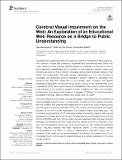Files in this item
Cerebral Visual Impairment on the web : an exploration of an educational web resource as a bridge to public understanding
Item metadata
| dc.contributor.author | Ravenscroft, John | |
| dc.contributor.author | St Clair Tracy, Helen | |
| dc.contributor.author | Blaikie, Andrew | |
| dc.date.accessioned | 2021-09-15T15:30:29Z | |
| dc.date.available | 2021-09-15T15:30:29Z | |
| dc.date.issued | 2021-09-15 | |
| dc.identifier | 275669758 | |
| dc.identifier | c91d761b-340b-4ee1-bc1b-8a82ddf3db8c | |
| dc.identifier | 000702239200001 | |
| dc.identifier.citation | Ravenscroft , J , St Clair Tracy , H & Blaikie , A 2021 , ' Cerebral Visual Impairment on the web : an exploration of an educational web resource as a bridge to public understanding ' , Frontiers in Communication , vol. 6 , 727230 . https://doi.org/10.3389/fcomm.2021.727230 | en |
| dc.identifier.issn | 2297-900X | |
| dc.identifier.other | ORCID: /0000-0001-7913-6872/work/100172710 | |
| dc.identifier.uri | https://hdl.handle.net/10023/23963 | |
| dc.description.abstract | Cerebral Visual Impairment (CVI) is the most common form of childhood visual impairment. Yet it remains the least well understood by parents and professionals alike. There is an urgent need to provide a bridge between academic knowledge concerning CVI, and to give a practical understanding of the condition to those affected, parents, carers, and professionals alike so that a common language can be shared between patients, their carers and professionals. The wide ranging manifestations of CVI, and the lack of accessible well recognised terms to describe it, render it difficult to understand how someone with their own unique form of CVI actually “sees”. However, with graded progressive explanation, knowledge can be gained, leading to an understanding of the visual effects of CVI from the perspective of those affected. The current position of limited understanding of the condition presents a major challenge for health and education professionals: How does one bring about the requisite CVI literacy, to render the subject accessible to families, affected children and adults, and the public? One way of doing this is by means of a plain language, multi-media resource, hosted on a publicly available website, driven by a partnership of adults with CVI, parents of children with the condition and experienced professionals from around the world, including those from the vision sciences and education. Within this context, we have explored the website resource of the not-for-profit organisation CVI Scotland (https://cviscotland.org/). This comprises a growing body of CVI knowledge created for teaching, sharing, learning and developing knowledge and understanding. By analysing anonymised data concerning the activity of 80,000 users from 170 countries, we have examined where the users who are accessing the website come from, what users are seeking in terms of information, how they have accessed the website, and what devices they use. The results are interpreted though frequency analysis and linear regression. Based on this analysis several recommendations are made in terms of disseminating information about CVI to members of the public as well as developments to enhance the website itself. To our knowledge this is the first study to examine the use of a website dedicated to CVI using Google analytics. | |
| dc.format.extent | 13 | |
| dc.format.extent | 1124853 | |
| dc.language.iso | eng | |
| dc.relation.ispartof | Frontiers in Communication | en |
| dc.subject | Cerebral visual impairment | en |
| dc.subject | CVI literacy | en |
| dc.subject | Public understanding | en |
| dc.subject | Google Analytics | en |
| dc.subject | Web analysis | en |
| dc.subject | RC0321 Neuroscience. Biological psychiatry. Neuropsychiatry | en |
| dc.subject | QA76 Computer software | en |
| dc.subject | ZA4050 Electronic information resources | en |
| dc.subject | NDAS | en |
| dc.subject.lcc | RC0321 | en |
| dc.subject.lcc | QA76 | en |
| dc.subject.lcc | ZA4050 | en |
| dc.title | Cerebral Visual Impairment on the web : an exploration of an educational web resource as a bridge to public understanding | en |
| dc.type | Journal article | en |
| dc.contributor.institution | University of St Andrews. School of Medicine | en |
| dc.contributor.institution | University of St Andrews. Sir James Mackenzie Institute for Early Diagnosis | en |
| dc.contributor.institution | University of St Andrews. Infection and Global Health Division | en |
| dc.identifier.doi | https://doi.org/10.3389/fcomm.2021.727230 | |
| dc.description.status | Peer reviewed | en |
This item appears in the following Collection(s)
Items in the St Andrews Research Repository are protected by copyright, with all rights reserved, unless otherwise indicated.

